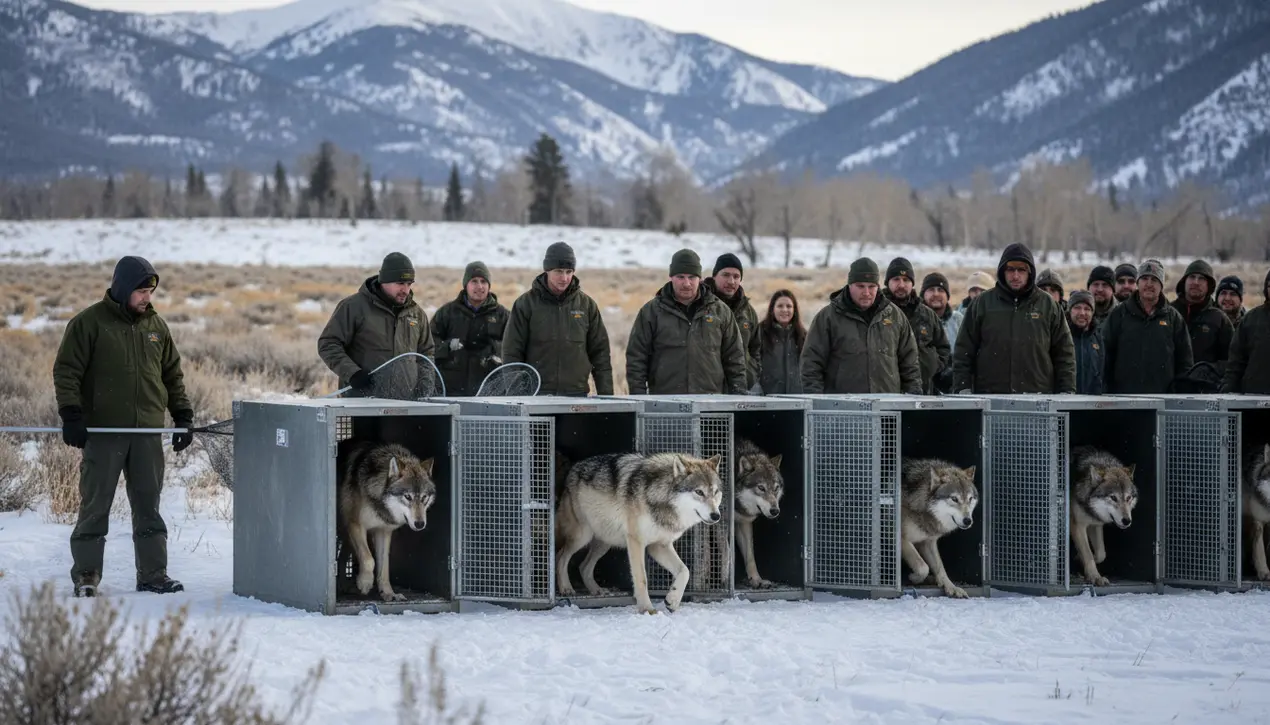
SciencebiologyEvolution and Ecology
Colorado wolf reintroduction faces deaths and challenges.
RA
Rachel Adams
18 hours ago7 min read4 comments
On a crisp morning two years ago, a solemn group of state officials gathered in the mountains of northwestern Colorado, standing before a line of large metal crates that held within them one of the continent's most contentious ecological legacies. With a small, watchful crowd present, the latches were thrown open, and out stepped gray wolves—the vanguard of an unprecedented voter-mandated effort to mend a broken ecosystem.This moment, charged with hope and controversy, marked the beginning of a daring attempt to reverse a historical wrong; by the 1940s, a government-backed extermination campaign had wiped out Colorado's resident wolf population. The 2020 ballot measure that initiated this reintroduction was not merely about returning a charismatic species to the landscape but about restoring a fundamental ecological balance.As apex predators, wolves exert a regulatory force on deer and elk populations, which in their unchecked numbers can devastate native vegetation, spread chronic wasting disease, and even increase vehicle collisions, a dynamic supported by research published in the Proceedings of the National Academy of Sciences. The initial phases saw ten wolves translocated from Oregon in the winter of 2023, followed by fifteen from Canada in January of this year, with Colorado Parks and Wildlife (CPW) outlining an ambitious plan to release 30 to 50 animals over three to five years to establish a self-sustaining population.Governor Jared Polis heralded the first release as a historic return, a sentiment that now feels tempered by a stark new reality. A decade of progress has been punctuated by significant loss: ten of the transplanted wolves, plus one of their wild-born pups, are already dead.The causes of mortality read like a catalog of the challenges facing large carnivores in a human-dominated world. State officials confirmed that one wolf fell to intra-species conflict, two were likely killed by mountain lions, one was struck by a vehicle, and another succumbed after stepping into a coyote trap.In a tragic irony, two more were killed by officials themselves—one by CPW for chronic livestock depredation and another by the US Department of Agriculture's Wildlife Services after it wandered into Wyoming, a state with permissive wolf-killing laws. This conflict with livestock, despite mitigation efforts like state-funded 'range riders,' underscores the profound difficulty of coexistence.The program's troubles are compounded by a logistical crisis; Colorado is now struggling to source the 10 to 15 wolves planned for release next winter. A recent directive from the US Fish and Wildlife Service has complicated imports from Canada, and a hoped-for partnership with Washington state collapsed when officials there, concerned about their own declining wolf numbers, voted against exporting animals.Other states like Montana and Wyoming have previously refused cooperation. Meanwhile, the financial costs have soared millions of dollars beyond initial projections.Yet, amidst the death toll and political friction, there are fragile signs of success. Trail camera footage released by CPW over the summer showed three wolf pups stumbling on oversized paws, play-biting and exploring their new world.The agency now confirms four litters have been born in Colorado, a vital indicator that the predators are settling in and establishing territories. As University of Colorado Boulder ecologist Joanna Lambert, a science adviser to the Rocky Mountain Wolf Project, emphasizes, this is a long game.The high mortality rate, while alarming, is not entirely unexpected given natural wolf dynamics, but it is exacerbated by the pervasive human footprint. The ultimate test of this reintroduction will be whether a resilient, breeding population can take root despite the immense pressures, serving as a stark reminder that healing a wounded ecosystem is a complex, costly, and often heartbreaking endeavor, but one signaled by the hopeful howls of a new generation.
#wolves
#reintroduction
#Colorado
#conservation
#endangered species
#featured
#ecosystem restoration
#wildlife management
Stay Informed. Act Smarter.
Get weekly highlights, major headlines, and expert insights — then put your knowledge to work in our live prediction markets.
Related News
Comments
Loading comments...
© 2025 Outpoll Service LTD. All rights reserved.